Museum of the Royal Tombs of Aigai (Vergina)
 Entrance to the Royal Tombs of Aigai Museum in Vergina, Greece | |
 | |
| Established | 1997 |
|---|---|
| Location | Vergina, Central Macedonia, Greece |
| Coordinates | 40°29′N 22°19′E / 40.483°N 22.317°ECoordinates: 40°29′N 22°19′E / 40.483°N 22.317°E |
| Type | Archaeological |
| Website | https://aigai.gr/www.aigai.gr/en/explore/polycentric-museum-aigai.html |
The Museum of the Royal Tombs of Aigai (Vergina) is located 75 km west of Thessaloniki, Greece, centered around the royal tombs built by the ancient Kingdom of Macedon at Aigai. The underground museum containing the burial cluster of Philip II of Macedon began construction in 1993 and was inaugurated in 1997. Exhibits are presented in four interconnected areas, including the Palace, the royal burial cluster of the Temenid dynasty (burial cluster "C"), the burial cluster of Philip II , and a gateway entrance with a semi-open-air exhibition of the sculptures found in the city sanctuaries and the restored upper floor of the Palace of Philip's facade.
The collections housed in the museum are the grave goods recovered from a series of archaeological excavations beginning in 1861 and continue to the present day.[1]
Archaeology[]
Archaeologists were interested in the burial mounds around Vergina as early as the 1855 AD, supposing that the site of Aigai was in the vicinity. However, nothing more than empty tombs were found.[2] Excavations began again in 1861 under the French archaeologist Leon Heuzey, sponsored by Napoleon III. Parts of a large building that was considered to be one of the palaces of Antigonus III Doson (263–221 BC), partly destroyed by fire, were discovered near Palatitsa, which preserved the memory of a palace in its modern name. The excavators suggested that this was the site of the ancient city of Valla, a view that prevailed until 1976. However, the excavations had to be abandoned because of the risk of malaria.[3]
The first royal tomb was discovered by Konstantinos Romaios, professor of archaeology at Aristotle University of Thessaloniki who uncovered it while working in the remains of the palace between 1937 and 1940. Much of the palace had been scavenged for construction materials by Greek refugees, who had been resettled there from Turkish Anatolia after the Greco-Turkish War. They built a new settlement at the site which they named Vergina after a legendary queen in 1922. But, the excavations were abandoned on the outbreak of war with Italy in 1940. World War II was followed by the Greek Civil War (1946-1949).
In 1949, excavations were finally resumed by Manolis Andronikos. Andronikos completed the palace excavations in 1970 then turned his attention to the Great Tumulus that he was convinced was a burial mound concealing the tombs of the Macedonian kings. There, in 1977, Andronikos uncovered four buried tombs, two of which had never been disturbed. Andronikos identified these as the tomb of Philip II, father of Alexander the Great (Tomb II) and also of Alexander IV of Macedon, son of Alexander the Great and Roxana (Tomb III).
In 1987, a burial cluster including the tomb of Queen Queen Eurydice I was discovered. Between 1991 and 2009, over 1,000 tombs were excavated along with city districts, farm houses, cemeteries, streets, sanctuaries and parts of the city fortification. A royal burial cluster of the Temenids, an ancient Macedonian royal house of Dorian Greek provenance, is also revealed. Then in March 2014, five more royal tombs thought to possibly belong to Alexander I of Macedon and his family or to the family of Cassander were discovered.[1]
Exhibition areas[]
The Palace, a structure three times the size of the Parthenon at 70,000 square feet, (Realm) is thought to have been constructed by the architect Pythius of Priene, known for his contribution to the construction of the Mausoleum at Halicarnassus. Nearly 30 large columns that surrounded the palace's main peristyle have been reconstructed, some towering to a height of 25 ft.[4] The frieze on the peristyle's southern section has also been reconstructed.[5] Over 5,000 square feet of mosaics depicting a range of scenes, including the ravishing of Europa and motifs from nature have been carefully conserved. Reinforcement of the fortification walls will be completed by 2022.[4] The building's design follows the mathematical and philosophical prototype based on the golden ratio. This embodies both the golden Pythagorean triangle and Plato’s idea on the construction of the “Soul of the World” as formulated in the Timaeus.[6]
At the southwestern edge of the cemetery of the tumuli, next to the old Town Hall of Vergina and on the road leading to the Palace, works are in progress for the modification and promotion of the royal burial cluster of the Temenid dynasty. This tomb complex consists of three Macedonian tombs, two hypostyle tombs and a series of monumental cist graves dated back to a period extending from the first half of the 6th century BCE to the beginning of the 3rd century BCE. The four-tomb grouping that became known as the “tomb cluster of Philip II” contains the burials of Philip II, his sixth wife, Queen Meda of Odessos, originally a Thracian princess, Alexander IV, son of Alexander the Great and Roxana, and another distinctive family member thought to be Nicesipolis (sometimes spelled Nikesipolis), Philip's Thessalian wife.[1]
Among the objects found in the tomb of Philip II were a golden larnax emblazoned with the sixteen-rayed "Sun of Vergina" on its lid, containing the king's bones, an intricate gold burial wreath, a silver and gold diadem with Heracles knot, silver and bronze vessels from the funeral feast, and carved ivory ornaments from the funeral couch. Gold accented armor and greaves with one custom fitted to Philip's leg deformed by an improperly healed broken tibia, ivory inlaid shields, weapons, ivory reliefs, jewelry, and terracotta votive figurines were also found. Similar objects found in the other tombs, including the jewelry and body adornments from the 9th century BCE "Lady of Aigai" are also presented. Many of these objects were initially displayed in the Archaeological Museum of Thessaloniki, but are now on display in this museum.
A virtual museum, “Alexander the Great, from Aigai to the World” and a model of the entire archaeological site is planned for the main entrance hall.[1] Funding for the project came from the EU's NSRF business program on “Competitiveness, Entrepreneurship and Innovation”, which will provide 10 million euros in total for the reconstruction, expected to be completed by the end of 2022.[5]
Gallery[]

Golden larnax of Philip II of Macedon with Star of Vergina
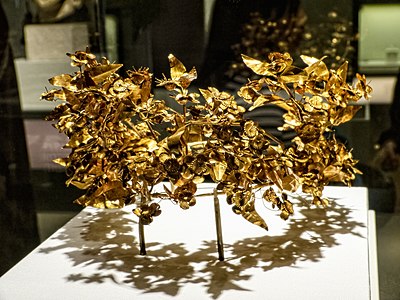
Gold funeral wreath of Queen Meda, Philip II's sixth wife

Ivory plaque depicting a boar from the footrest of Philip II's funeral couch

Philip II's silver and gold diadem with Heracles knot

Silver Oinochoe with Silenus relief

Bronze lantern with Pan relief

Closeup of Pan relief on bronze lantern

Gold Gorgon Head from Philip II's cuirass (breastplae)

Philip II's bronze greaves
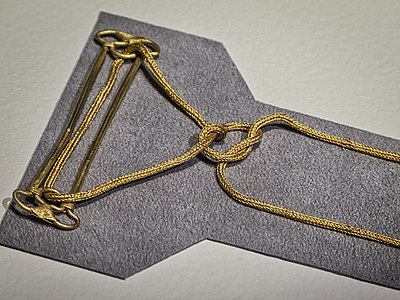
Gold two-pin fibula with chain tied in a Heracles knot
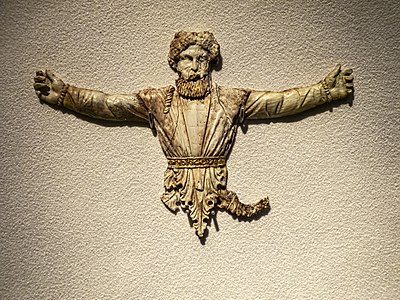
Ivory gold miniature of Sabazios from the tomb of Alexander IV

Remains of Philip II's funeral pyre
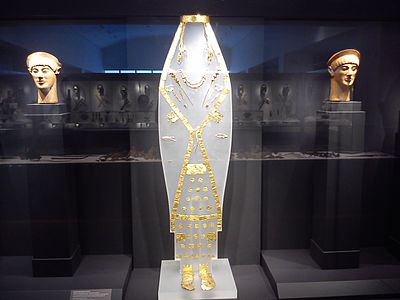
Gold jewelry and garment ornaments of a Macedonian Queen at Aigai
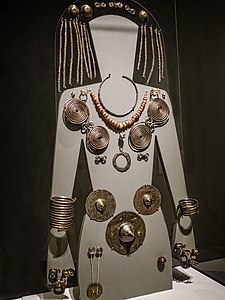
9th century BCE grave goods of the "Lady of Aigai"
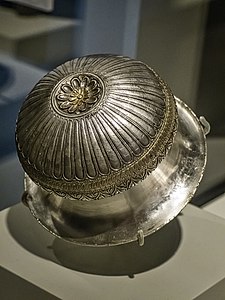
Silver cup from the tomb of Philip II

Silver kylix from the tomb of Philip II

The gold gorytos (combination quiver and bow case), shin-guards and neck armor of Queen Meda of Odessos, Philip II's sixth wife

Detail of tomb fresco depicting Hades abducting Persephone
References[]
| Wikimedia Commons has media related to Macedonian royal tombs, Vergina. |
- ^ Jump up to: a b c d "Museum of the Royal Tombs of Aigai". Aigai: The Royal Capital of Macedon. Ephorate of Antiquities of Imathia. Retrieved 17 December 2020.
- ^ Grant, David. "The Royal Macedonian Tombs at Vergina". World History Encyclopedia. Retrieved 17 December 2020.
- ^ M. Andronikos,"Anaskafi sti Megali Toumpa tis Verginas" Archaiologica Analekta Athinon 9(1976), 127–129.
- ^ Jump up to: a b Mandal, Dattatreya. "Philip II's massive palace at Aigai to be opened for the public in May". Realm of History. Retrieved 17 December 2020.
- ^ Jump up to: a b "Philip II's palace at Aigai to open to the public in May". The Greek Observer. Retrieved 17 December 2020.
- ^ Perry, Carolyn. "Philip II's Palace at Vergina: new discoveries". Time Traveling With Carolyn. Retrieved 17 December 2020.
- Museums in Greece
- Archaeological museums in Central Macedonia
- Philip II of Macedon
- 1993 establishments in Greece
- Tombs in Greece
- Buildings and structures in Imathia


















